Related Research Articles

The horse is a domesticated, one-toed, hoofed mammal. It belongs to the taxonomic family Equidae and is one of two extant subspecies of Equus ferus. The horse has evolved over the past 45 to 55 million years from a small multi-toed creature, close to Eohippus, into the large, single-toed animal of today. Humans began domesticating horses around 4000 BCE, and their domestication is believed to have been widespread by 3000 BCE. Horses in the subspecies caballus are domesticated, although some domesticated populations live in the wild as feral horses. These feral populations are not true wild horses, which are horses that never have been domesticated and historically linked to the megafauna category of species. There is an extensive, specialized vocabulary used to describe equine-related concepts, covering everything from anatomy to life stages, size, colors, markings, breeds, locomotion, and behavior.
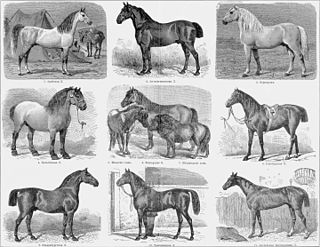
A horse breed is a selectively bred population of domesticated horses, often with pedigrees recorded in a breed registry. However, the term is sometimes used in a broader sense to define landrace animals of a common phenotype located within a limited geographic region, or even feral "breeds" that are naturally selected. Depending on definition, hundreds of "breeds" exist today, developed for many different uses. Horse breeds are loosely divided into three categories based on general temperament: spirited "hot bloods" with speed and endurance; "cold bloods," such as draft horses and some ponies, suitable for slow, heavy work; and "warmbloods," developed from crosses between hot bloods and cold bloods, often focusing on creating breeds for specific riding purposes, particularly in Europe.

The Akhal-Teke is a Turkmen horse breed. They have a reputation for speed and endurance, intelligence, and a distinctive metallic sheen. The shiny coat of the breed led to their nickname, "Golden Horses". These horses are adapted to severe climatic conditions and are thought to be one of the oldest existing horse breeds. There are currently about 6,600 Akhal-Tekes in the world, mostly in Turkmenistan, although they are also found throughout Europe and North America. Akhal is the name of the line of oases along the north slope of the Kopet Dag mountains in Turkmenistan. It has been inhabited by the Tekke tribe of Turkmens.
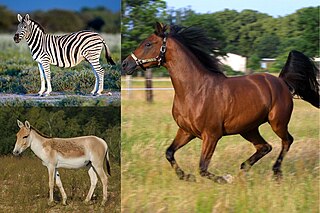
Equus is a genus of mammals in the family Equidae, which includes horses, asses, and zebras. Within the Equidae, Equus is the only recognized extant genus, comprising seven living species. Like Equidae more broadly, Equus has numerous extinct species known only from fossils. The genus most likely originated in North America and spread quickly to the Old World. Equines are odd-toed ungulates with slender legs, long heads, relatively long necks, manes, and long tails. All species are herbivorous, and mostly grazers, with simpler digestive systems than ruminants but able to subsist on lower-quality vegetation.

The Dales Pony is a British breed of pony or small horse. It originated in, and is named for, the Dales of Yorkshire in northern England. It is one the nine native mountain and moorland pony breeds of the United Kingdom, and belongs to the broader Celtic group of ponies which extends from Portugal and northern Spain to Scandinavia.

The Exmoor Pony is a British breed of pony or small horse. It is one of the mountain and moorland pony breeds native to the British Isles, and so falls within the larger Celtic group of European ponies. It originates on, and is named for, the Exmoor area of moorland in north-eastern Devon and western Somerset, in south-west England, and is well adapted to the climate conditions and poor grazing of the moor. Some still live there in a near-feral state, but most are in private ownership.

The Marwari or Malani is a rare breed of horse from the Marwar region of Rajasthan, in north-west India. It is closely related to the Kathiawari breed of the Kathiawar peninsula of Gujarat, with which it shares an unusual inward-curving shape of the ears. It is found in all equine colours, including piebald and skewbald. It is a hardy riding horse; it may exhibit a natural ambling gait.

The Florida Cracker Horse is a critically endangered horse breed from the state of Florida in the United States. It is genetically and physically similar to many other Spanish-style horses, especially those from the Spanish Colonial horse group, including the Banker horse of North Carolina, and the Carolina Marsh Tacky of South Carolina.

The Lundy Pony is a British breed of pony bred on Lundy Island in the twentieth century.
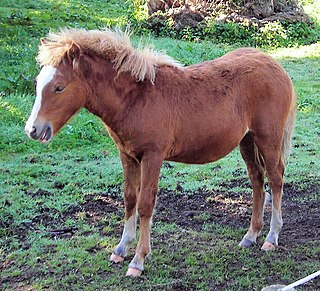
The Kerry Bog Pony is a mountain and moorland breed of pony that originated in Ireland. Possibly descended from the Irish Hobby horse, it originally lived a mainly feral existence in the peat bogs of what is now County Kerry in southwestern Ireland. Local inhabitants used the ponies as pack and cart horses for transporting peat and kelp to the villages. The breed developed physical characteristics including a low weight-to-height ratio and an unusual footfall pattern, which helped it move on soft ground such as peat bogs. The ponies were known for hardiness and an ability to survive in harsh conditions.
The Banker horse is a breed of semi-feral or feral horse living on barrier islands in North Carolina's Outer Banks. It is small, hardy, and has a docile temperament, and is genetically related to the Carolina Marsh Tacky of South Carolina and Florida Cracker Horse breeds through their shared Colonial Spanish horse and Iberian horse descent. The current population of wild Banker horses is estimated to be about 400.
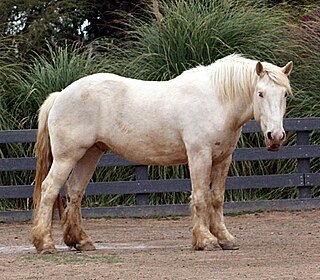
The American Cream Draft is an American breed of draft horse, characterized by the cream or "gold champagne" color of its coat. It was developed in Iowa during the early twentieth century from a cream-colored mare named Old Granny. A breed registry was formed in 1944 but became inactive for several decades when breed numbers dropped due to the mechanization of farming. It was reactivated in 1982 and population numbers have slowly grown since then. It is a rare breed: its conservation status is considered critical by The Livestock Conservancy and the Equus Survival Trust.

The Livestock Conservancy, formerly known as the American Livestock Breeds Conservancy (ALBC) and prior to that, the American Minor Breeds Conservancy, is a nonprofit organization focused on preserving and promoting rare breeds, also known as "heritage breeds" of livestock. Founded in 1977, through the efforts of livestock breed enthusiasts concerned about the disappearance of many of the US's heritage livestock breeds, The Livestock Conservancy was the pioneer livestock preservation organization in the United States, and remains a leading organization in that field. It has initiated programs that have saved multiple breeds from extinction, and works closely with similar organizations in other countries, including Rare Breeds Canada. With 3,000 members, a staff of eleven and a 19-member board of directors, the organization has an operating budget of over a million dollars.

The Carolina Marsh Tacky or Marsh Tacky is a critically endangered breed of horse, native to South Carolina. It is a member of the Colonial Spanish group of horse breeds, which also include the Florida Cracker Horse and the Banker horse of North Carolina. It is a small horse, well-adapted for use in the lowland swamps of its native South Carolina. The Marsh Tacky developed from Spanish horses brought to the South Carolina coast by Spanish explorers, settlers and traders as early as the 16th century. The horses were used by the colonists during the American Revolution, and by settlers for farm work, herding cattle and hunting throughout the breed's history.
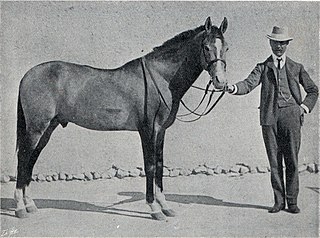
The Iomud is a breed of light horse from Turkmenistan. Like other breeds of Turkmen horse, it is named for the Turkmen tribe that raised it, the Iomud. Both the name of the horse and the name of the Turkmen clan may be spelt in many ways, including Iomud, Yomud, Yamud and Yomut. The Iomud horse is raised in Turkmenistan, particularly in the velayat of Daşoguz; in Uzbekistan; in Karakalpakstan, particularly in the Khwarezm region; and in Iraq, Iran and Turkey. Unlike the Akhal-Teke, it usually kept in herds in desert or semi-desert areas.

The Baudet du Poitou, also called the Poitevin or Poitou donkey, is a French breed of donkey. It is one of the largest breeds, and jacks were bred to mares of the Poitevin horse breed to produce Poitevin mules, which were formerly in worldwide demand for agricultural and other work. The Baudet has a distinctive coat, which hangs in long, ungroomed locks or cadenettes.
The history of horse domestication has been subject to much debate, with various competing hypotheses over time about how domestication of the horse occurred. The main point of contention was whether the domestication of the horse occurred once in a single domestication event, or that the horse was domesticated independently multiple times. The debate was resolved at the beginning of the 21st century using DNA evidence that favored a mixed model in which domestication of the stallion most likely occurred only once, while wild mares of various regions were included in local domesticated herds.

The horse genome was first sequenced in 2006. The Horse Genome Project mapped 2.7 billion DNA base pairs, and released the full map in 2009. The horse genome is larger than the dog genome, but smaller than the human genome or the bovine genome. It encompasses 31 pairs of autosomes and one sex chromosome pair.

The Lac La Croix Indian Pony (LLCIP), also known as the Ojibwe pony is a semi-feral Canadian horse breed developed by the Ojibwe people. The population became critically low; and, by 1977, only four mares remained. To preserve the breed, these mares were crossed with Spanish Mustang stallions. The modern breed name derives from the Lac La Croix First Nation of Ontario, where the horses were last found in the wild. Historically, the breed was also found in Minnesota.
References
- 1 2 "Trust Home Page". Equus Survival Trust. Retrieved 2009-02-17.
- ↑ "Endangered Equine Breeds Coming to Horse Park" . The Horse. August 29, 2008. Retrieved 2010-12-03.
- ↑ "Equus Survival Trust Equine Conservation List" (PDF). Equus Survival Trust. Retrieved 2008-02-17.
- ↑ "Owners of Endangered Equine Breeds Asked to Participate in Research Study" . The Horse. August 3, 2006. Retrieved 2009-02-17.
- ↑ "Endangered Marsh Tacky Horses DNA Tested for Conservation Effort" . The Horse. May 23, 2007. Retrieved 2009-02-17.
- ↑ "Equus Survival Trust Presenting Rare Breeds at Equine Affaire" . The Horse. October 26, 2006. Retrieved 2009-02-17.
- ↑ "National Endangered Breeds Weekend at KY Horse Park". The Dales Pony Society of America. Retrieved 2009-02-17.
- ↑ "US Akhal-Teke Championships and ATSA Annual Conference". Akhal-Teke Society of America. Archived from the original on 2008-10-28. Retrieved 2009-02-17.